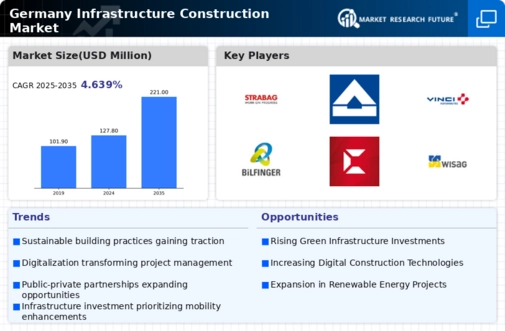The infrastructure construction market in Germany is characterized by a competitive landscape that is both dynamic and multifaceted. Key growth drivers include increasing urbanization, government investments in infrastructure, and a heightened focus on sustainability. Major players such as Hochtief AG (DE), Strabag SE (AT), and Bilfinger SE (DE) are strategically positioned to leverage these trends. Hochtief AG (DE) emphasizes innovation and digital transformation, aiming to enhance project efficiency through advanced technologies. Strabag SE (AT) focuses on regional expansion and strategic partnerships, which allows it to tap into diverse markets and optimize its service offerings. Bilfinger SE (DE) is concentrating on sustainability initiatives, aligning its operations with environmental standards, which is becoming increasingly crucial in the current market environment. Collectively, these strategies shape a competitive environment that is increasingly focused on technological advancement and sustainability.
In terms of business tactics, companies are localizing manufacturing and optimizing supply chains to enhance operational efficiency. The market structure appears moderately fragmented, with several key players exerting influence over various segments. This fragmentation allows for a diverse range of services and innovations, although it also intensifies competition among firms striving to differentiate themselves.
In November 2025, Hochtief AG (DE) announced a partnership with a leading technology firm to develop smart infrastructure solutions. This strategic move is significant as it positions Hochtief at the forefront of digital innovation, potentially enhancing its project delivery capabilities and operational efficiency. The integration of smart technologies is likely to attract new clients who prioritize modern solutions in their infrastructure projects.
In October 2025, Strabag SE (AT) secured a major contract for the construction of a new urban transit system in Berlin. This contract not only underscores Strabag's strong market presence but also highlights its commitment to regional expansion. The project is expected to enhance urban mobility and contribute to sustainable development, aligning with current governmental priorities.
In September 2025, Bilfinger SE (DE) launched a new initiative aimed at reducing carbon emissions across its construction projects. This initiative reflects a growing trend towards sustainability in the infrastructure sector. By prioritizing eco-friendly practices, Bilfinger is likely to enhance its reputation and appeal to environmentally conscious clients, thereby gaining a competitive edge.
As of December 2025, current competitive trends are increasingly defined by digitalization, sustainability, and the integration of AI technologies. Strategic alliances are shaping the landscape, enabling companies to pool resources and expertise to tackle complex projects. The shift from price-based competition to a focus on innovation, technology, and supply chain reliability is evident. Moving forward, competitive differentiation will likely hinge on the ability to adapt to these trends, with firms that prioritize technological advancements and sustainable practices poised to lead the market.

















Leave a Comment